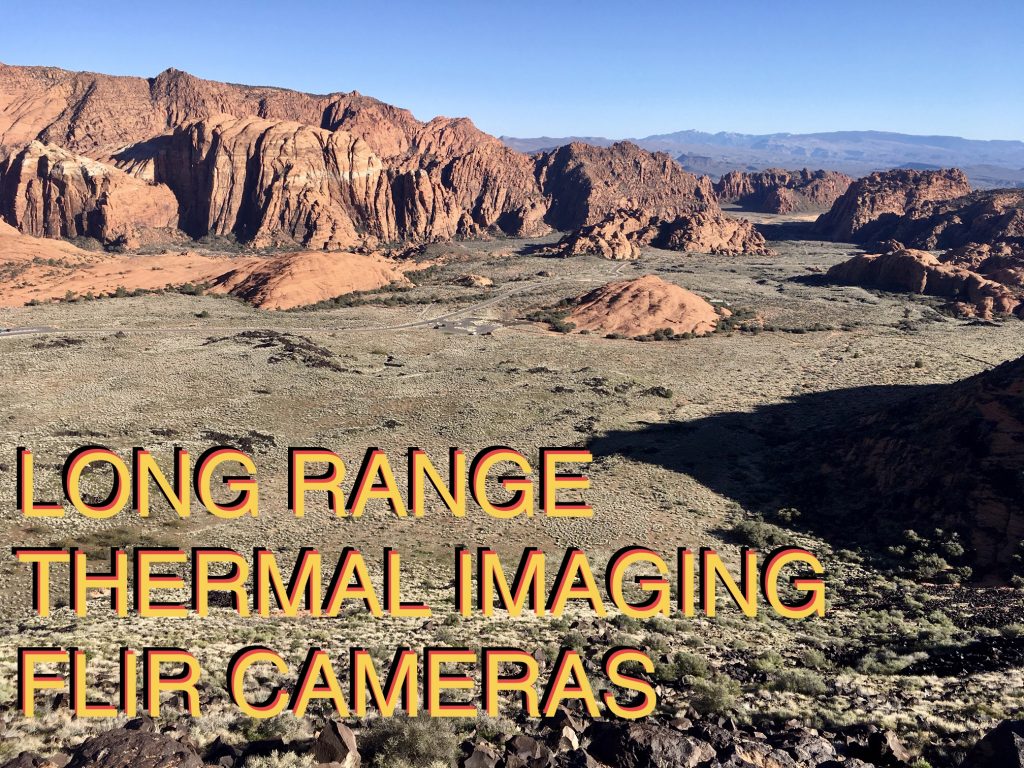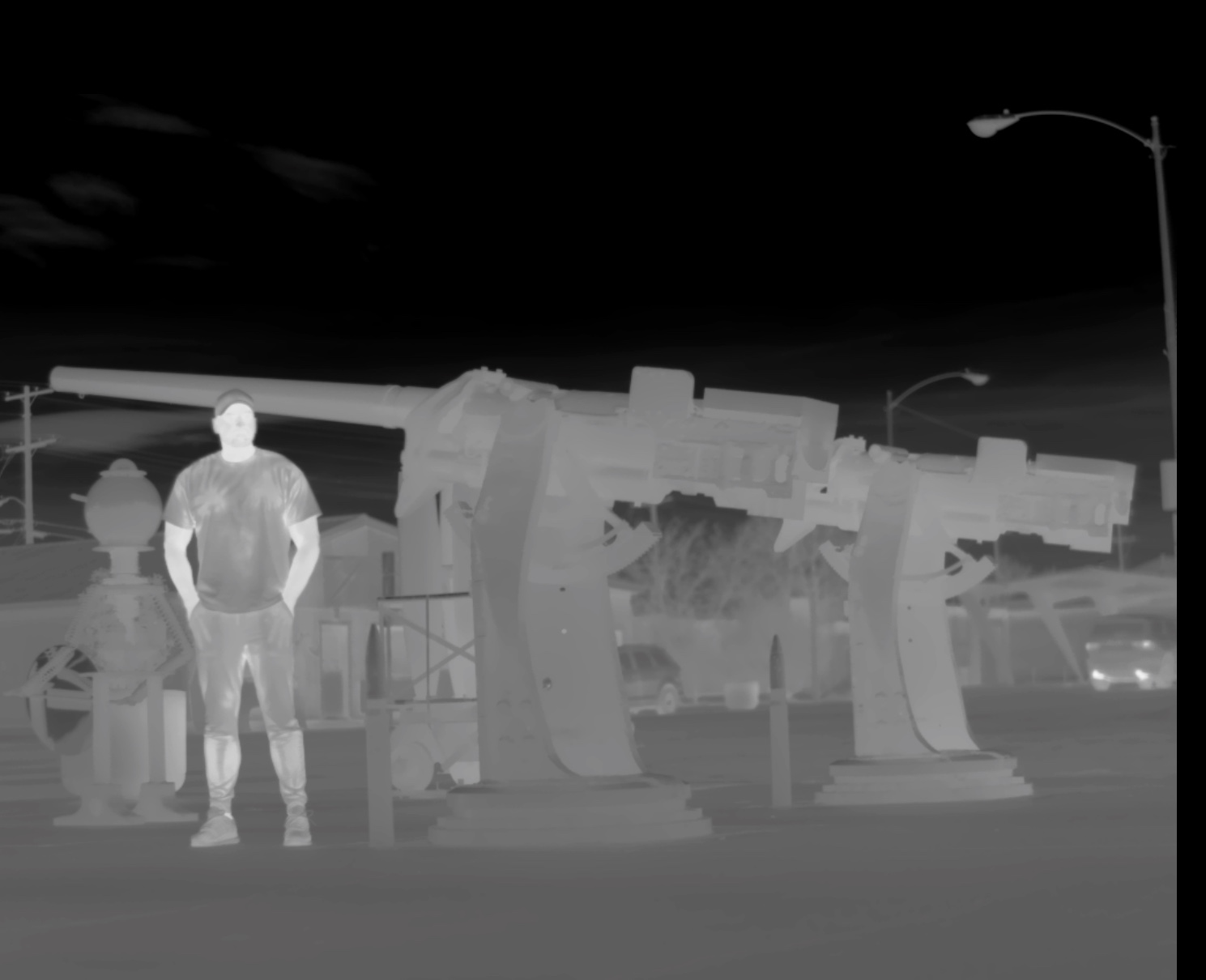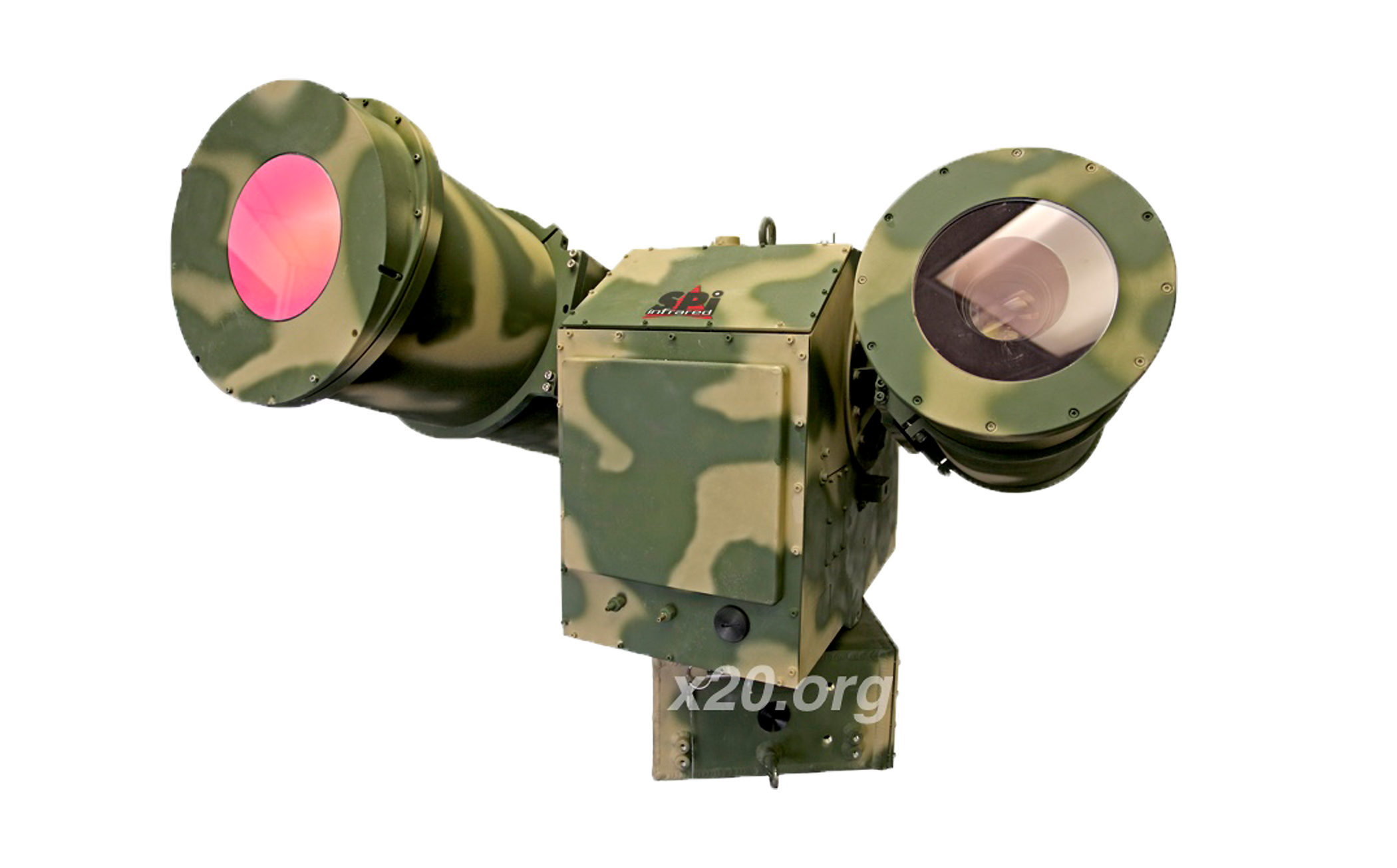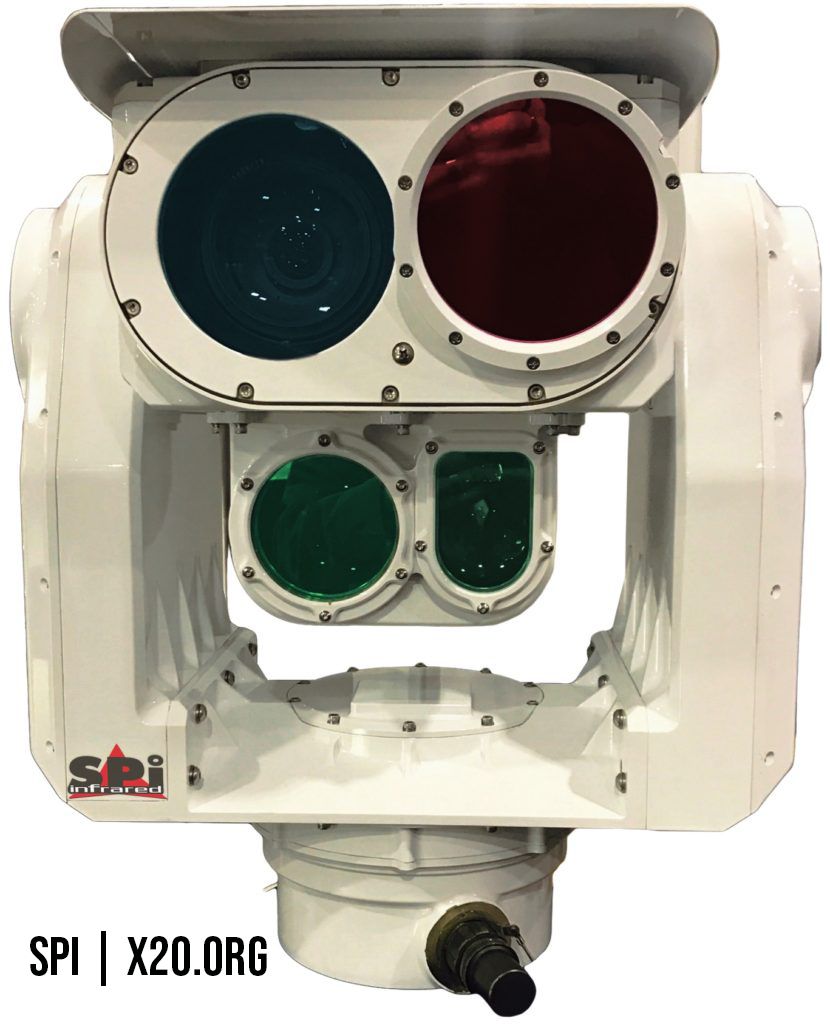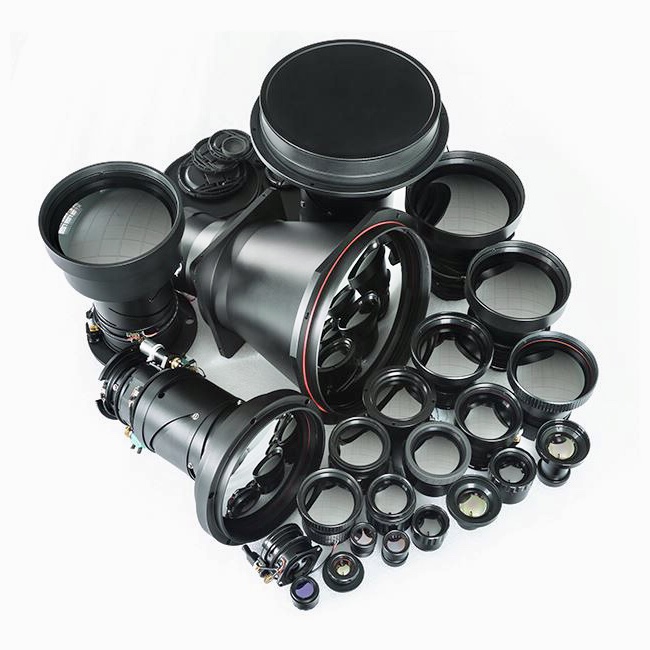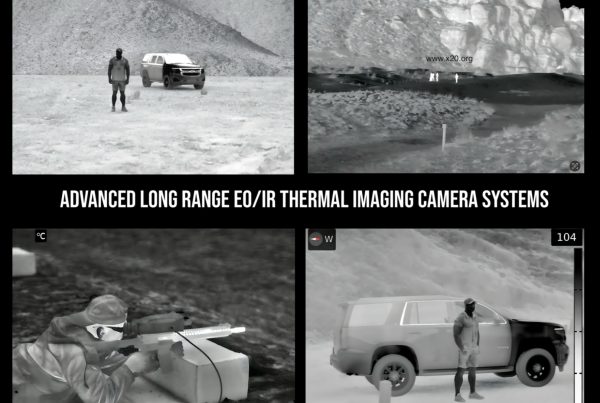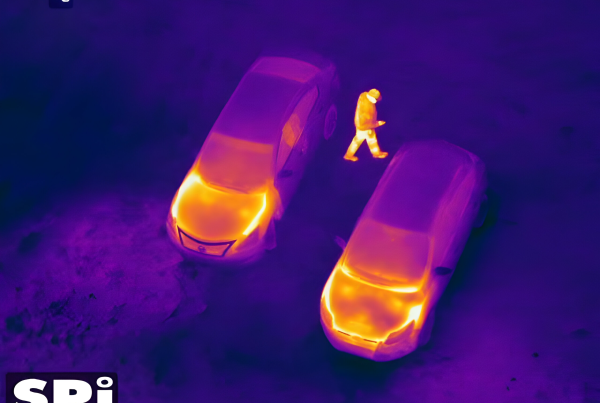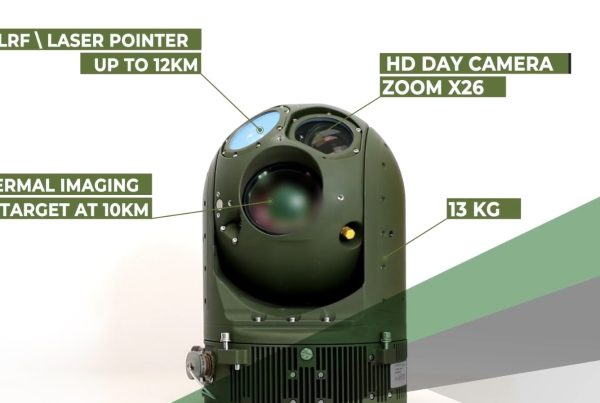Long range PTZ flir thermal
imaging camera resources
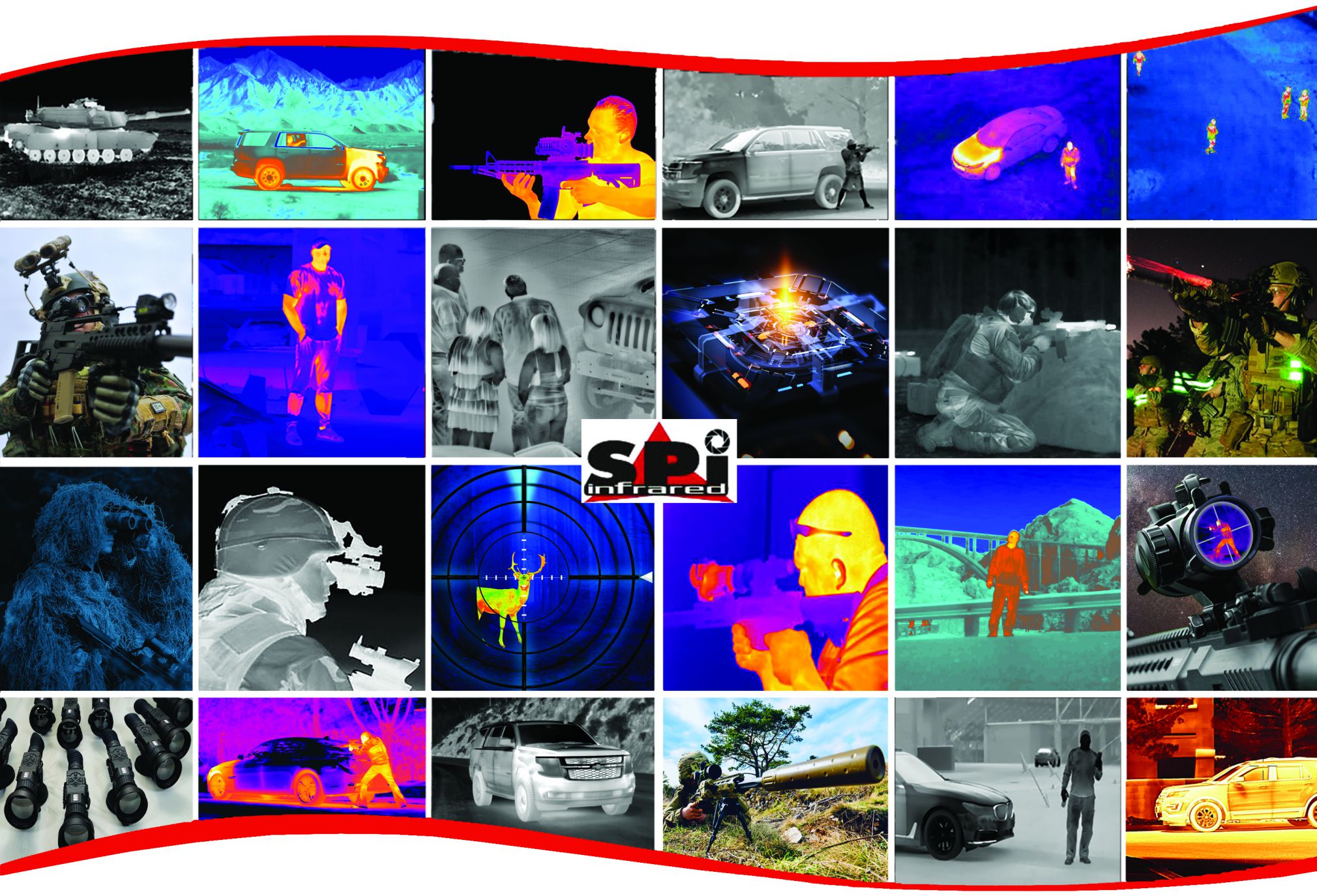 Long range flir camera with PTZ (Pan Tilt Zoom) positioning motorized gimbals are steerable thermal imaging video camera systems that are typically coupled with a daytime low light zoom camera (Multi Sensor) or (Dual Sensor).
Long range flir camera with PTZ (Pan Tilt Zoom) positioning motorized gimbals are steerable thermal imaging video camera systems that are typically coupled with a daytime low light zoom camera (Multi Sensor) or (Dual Sensor).
Long range flir camera systems are packaged onto a heavy duty gimbal positioner that Pans and Tilts the camera system to predetermined locations or are directed by a user moving the cameras with a joystick, keyboard or a computer system. These devices are built to withstand harsh environments typically in borders, shorelines, airports and other critical areas that require day and night security and surveillance in both The day and night. Long range thermal imaging cameras are heat sensing video cameras that can detect human or vehicle activity In low light or no light scenarios.
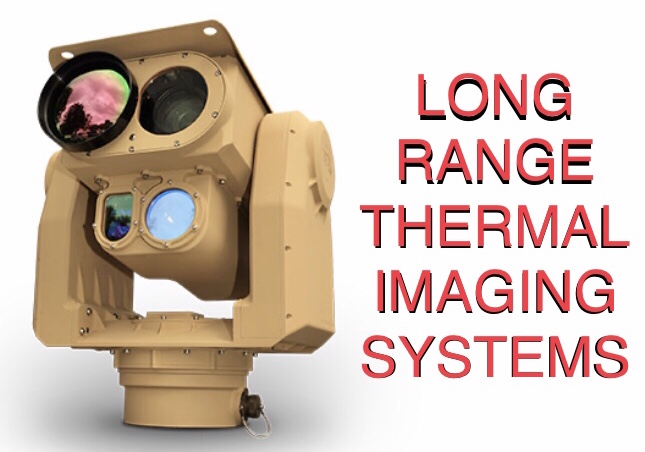
There are two primary types of long range thermal PTZ Flir cameras, the Uncooled LWIR and cooled MWIR types. The uncooled systems are made of primarily of amorphous silicon and microbolometer type detectors or FPA (focal plane arrays). The cooled midwave systems are made typically of mercury cadmium telluride or MCT and indium antimonide or INSB, the cooled MWIR variants are used for longer range applications and in Tropical environments where humidity is more prevalent. Cooled MWIR imaging systems have the capability of much longer distances due to the type of cryo- genic cooling and other exotic factors, these systems are more expensive than their uncooled LWIR counterparts. Both cooled and uncooled thermal imaging sensors come in SD standard definition or HD high definition resolution. Multiple type of sensors and modules can be integrated into a long range thermal imaging PTZ Flir camera system such as shortwave infrared SWiR, high speed cameras, near IR cameras NiR, Radars, LRAD devices, spotlights, Infrared laser rangefinder’s Or LRF, infrared laser pointers, designators and illuminators. In recent times we have integrated artificial intelligence AI and machine learning ML algorithms to our long range thermal imaging PTZ flir camera systems for added capabilities allowing the user to capture additional data in threat assessment.
Local control and monitoring can be achieved as well as remote IP Ethernet LAN PTZ connectivity with computers, tablets, IP controllers and software.
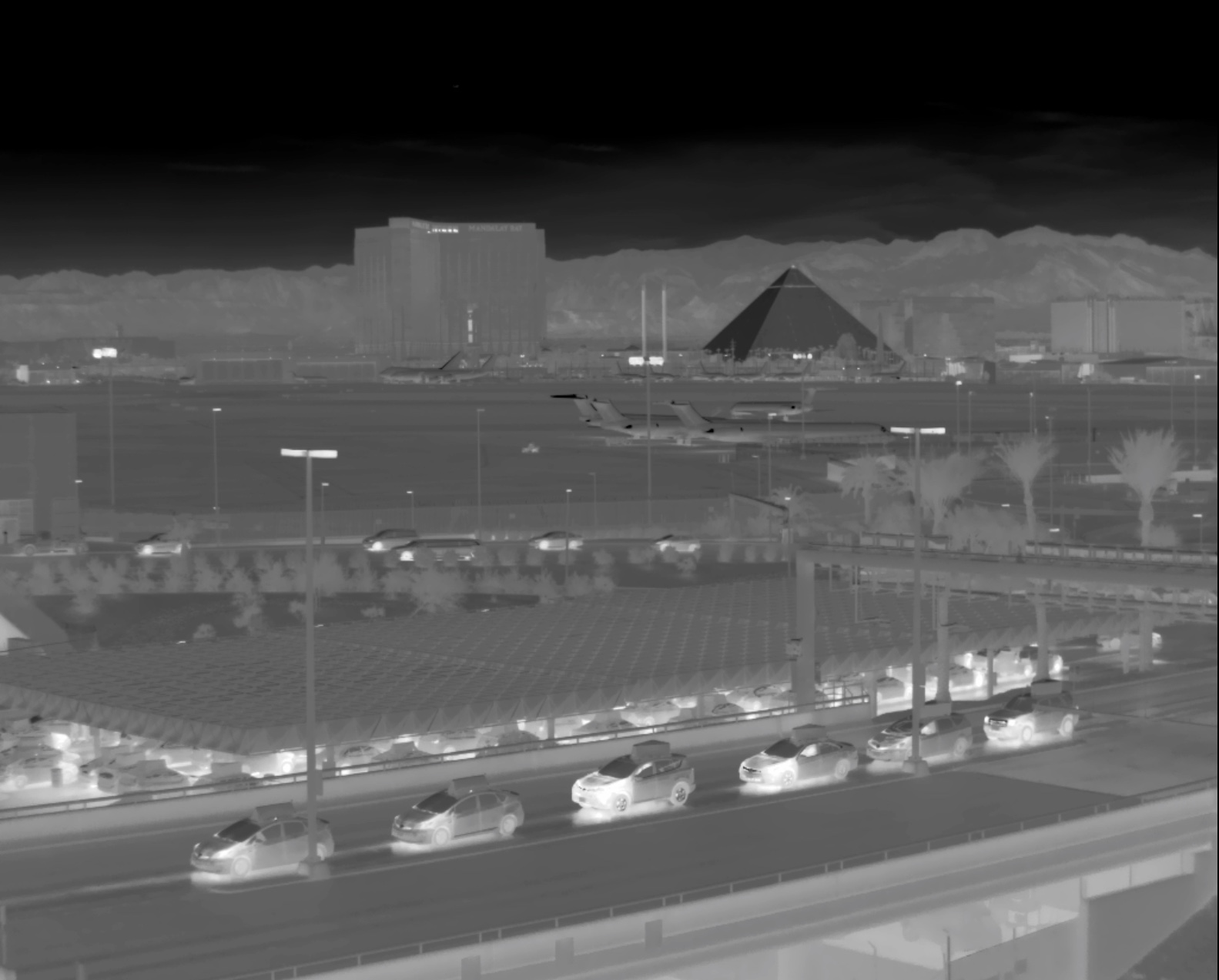 The long range thermal imaging PTZ flir cameras are sometimes integrated with LRF Laser rangefinders which display distance read outs of targets as well as IR Lasers pointers and illuminators for pointing out targets of interest or are used to illuminate very dark areas. Additional cameras such as SWIR (Short Wave Infrared) can be integrated as well as laser range finders LRF, Laser pointers and illuminators. A long range PTZ thermal or thermographic flir imaging camera collects electromagnetic radiation which is formed into an image. But while a conventional cmos/ccd, tv, eo or ccd/cctv cameras works in the range of visible light, i.e. with wavelengths between approximately 400 and 700 nanometers (0.4–0.7 μm), a thermal imaging flir camera is designed to detect radiation with greater wavelengths, up to around 14,000 nanometers (14 μm). Radiation in this part of the electromagnetic spectrum is referred to as infrared, or commonly IR, which in turn can be divided into several sub-groups. Near-infrared light has a wavelength of about 0.7–1.5 µm, which is just beyond what the human eye can see. Camera sensors, on the other hand, can be built to detect and make use of this type of radiation. A so-called day-and-night camera uses an IR-cut filter during daytime to filter out IR-light so it will not distort the colors of images as perceived by the human eye. When the camera is in night mode, the IR-cut filter is removed. Since the human eye is unable to see infrared light the camera displays the image in black and white. Near infrared light or NIR also requires some kind of light source – either natural, such as moonlight, or man-made, such as street lights or a dedicated IR-lamp.
The long range thermal imaging PTZ flir cameras are sometimes integrated with LRF Laser rangefinders which display distance read outs of targets as well as IR Lasers pointers and illuminators for pointing out targets of interest or are used to illuminate very dark areas. Additional cameras such as SWIR (Short Wave Infrared) can be integrated as well as laser range finders LRF, Laser pointers and illuminators. A long range PTZ thermal or thermographic flir imaging camera collects electromagnetic radiation which is formed into an image. But while a conventional cmos/ccd, tv, eo or ccd/cctv cameras works in the range of visible light, i.e. with wavelengths between approximately 400 and 700 nanometers (0.4–0.7 μm), a thermal imaging flir camera is designed to detect radiation with greater wavelengths, up to around 14,000 nanometers (14 μm). Radiation in this part of the electromagnetic spectrum is referred to as infrared, or commonly IR, which in turn can be divided into several sub-groups. Near-infrared light has a wavelength of about 0.7–1.5 µm, which is just beyond what the human eye can see. Camera sensors, on the other hand, can be built to detect and make use of this type of radiation. A so-called day-and-night camera uses an IR-cut filter during daytime to filter out IR-light so it will not distort the colors of images as perceived by the human eye. When the camera is in night mode, the IR-cut filter is removed. Since the human eye is unable to see infrared light the camera displays the image in black and white. Near infrared light or NIR also requires some kind of light source – either natural, such as moonlight, or man-made, such as street lights or a dedicated IR-lamp.
An example of an Uncooled LWIR Long Range PTZ thermal
imaging system is the M7 Falcon
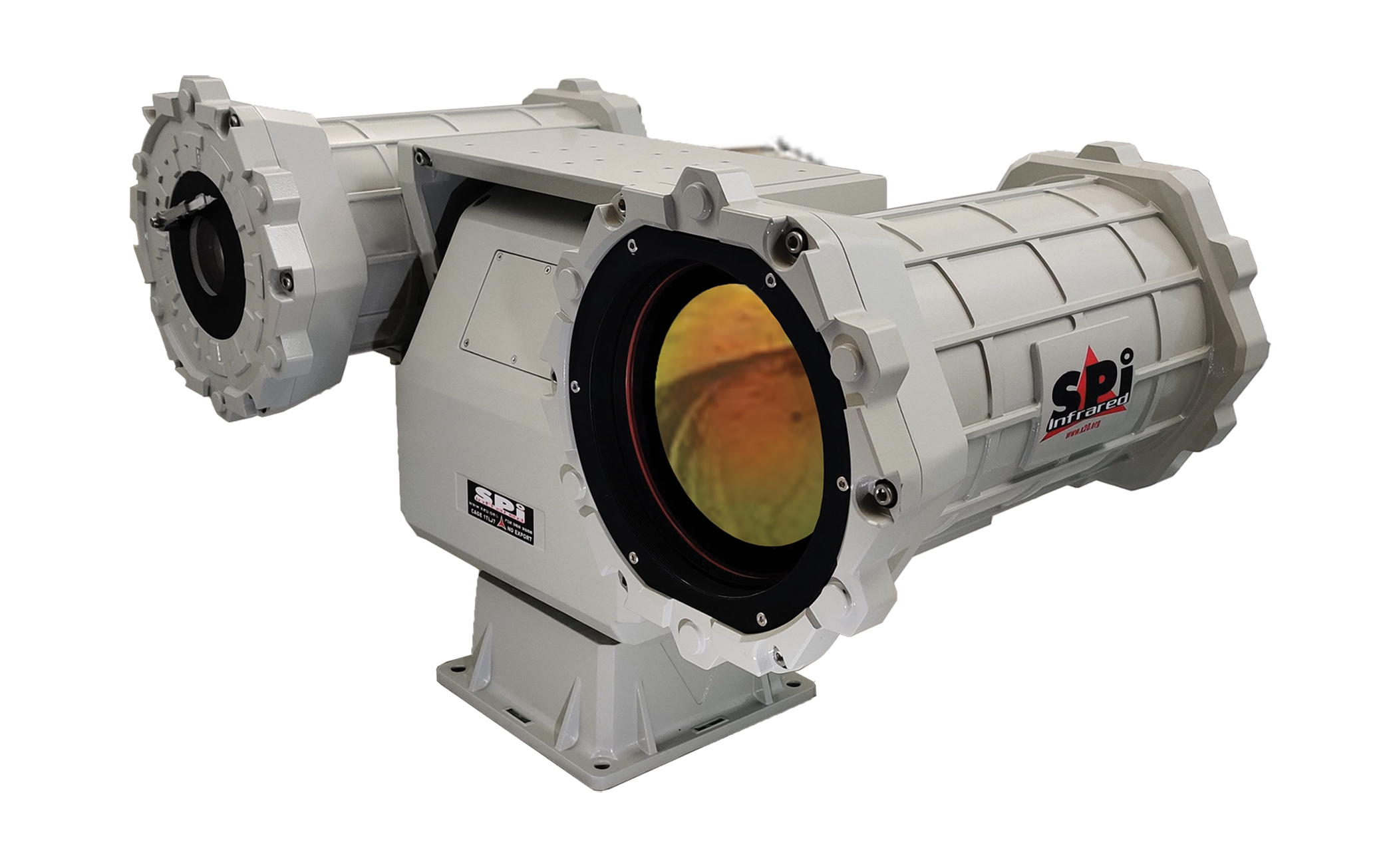
For example, Standard SD and HD Functionality from the Long range M7 IR PTZ Provides an optioanl 16:9 wide screen video that shows more of the important part of the scene and fits well on modern screens. The long range M7 thermal imaging camera is equipped with powerful continuous optical zoom capability on the thermal image. It offers excellent situational awareness but also the possibility to zoom-in, and see more detail, once a target has been detected. This way operators can see farther recognize more detail and react more quickly to security threats. The advantage of continuously zooming compared to other systems that are using a rotating lens system is that there is no switch or swapping between the different images. You can gradually zoom in while keeping your focus all the time. The unit has quick auto focus & has a plethora of upgradeability options to make sure the system stays current with your evolving surveillance network.
An Example of a cooled MWIR Long range PTZ
thermal imaging system is the M9
Moving further away from visible light, the rest of the IR-spectrum is usually divided into the following categories: Short-Wave Infrared (SWIR), approx. 1 – 3 µm Mid-Wave Infrared (MWIR), approx. 3 – 5 µm Long-Wave Infrared (LWIR), approx. 8 – 12 µm Very Long-Wave Infrared (VLWIR), approx. 12 – 25 µm Far-Wave Infrared (FWIR), approx. 25 µm – 1 000 µm or 1 mm Note that there is a gap between 5 µm (MWIR) and 8 µm (LWIR). This part of the waveband is virtually unusable for thermal imaging purposes because of the high spectral absorption of the atmosphere in this range. Microwaves have a wavelength exceeding 1 mm. At the far end of the spectrum are radio waves, with a wavelength of 1 meter and more. In the other end of the spectrum, wavelengths shorter than those of visible light are successively referred to as ultraviolet, x-rays, and gamma rays. IR laser pointers, designators as well as LRF laser rangefinders are integrated into PTZ long range thermal imaging camera systems for added vision enhancement, distance to target measurement and pointing out targets of interest in the IR spectrum for other NIR imagers to see as well as users of night vision goggles or NVG’s
An object’s thermal radiation is also dependent on its temperature – the hotter it is the more thermal radiation it emits. Humans cannot see this, but we can sense it, for example, when we approach a camp fire or enter a sauna. The greater the temperature difference in a scene, the clearer will the thermal flir images will be. Furthermore, some materials will have a different emissivity in the mid-wave infrared spectrum than in the long-wave span. For imaging purposes these differences in emissivity are, for the most part, of secondary importance since the camera’s sensitivity can be defined as its capability to distinguish between temperature differentials. Thermal images are sometimes associated with bright, intense colors – which may seem a bit odd considering that the camera works outside the spectrum of visible light. The answer is that the colors are created digitally, so-called pseudo-colors but produce a very vivid crisp useable picture. Each color or nuance represents a different temperature, usually white and red for higher temperatures, over green, blue and violet for colder ones. The reason is foremost practical since the human eye is better at distinguishing different shades of color than different shades of grey. Detectors used for thermal imaging can be broadly divided into two types: Cooled thermal imagers that typically operate in the mid-wave infrared (Long range MWIR) band and uncooled thermal imagers that operate in the long-wave infrared (long range LWIR) band. Ultra Extreme long range Cooled and uncooled systems both have thier advantages in the world of distant range narrow FOV thermal imaging applications.
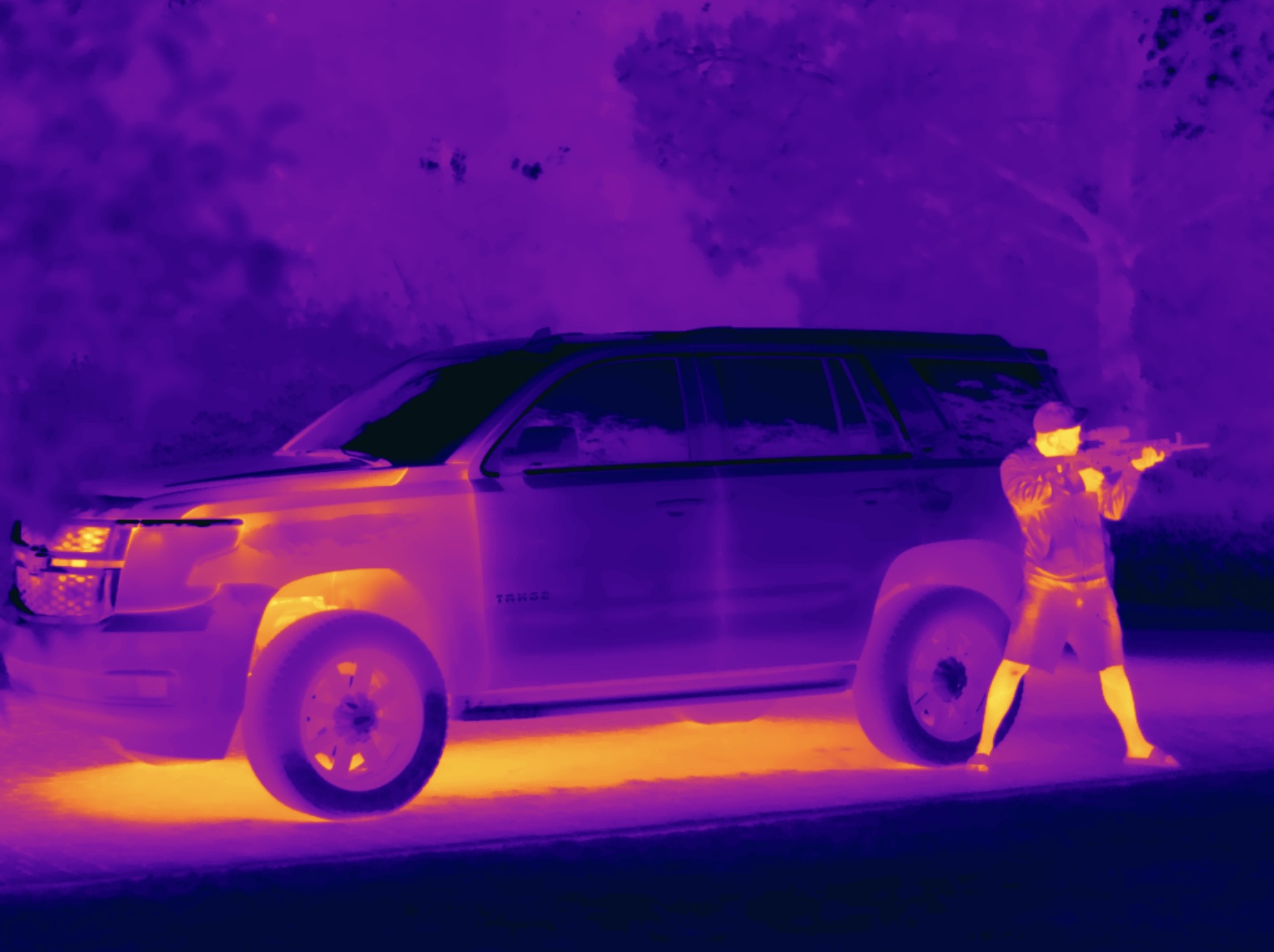 With PTZ or pan / tilt / zoom thermal imaging becoming relatively cheaper and an integral part of Short, medium, long and extreme ultra long range Surveillance, security, observation systems, a whole range of uses becomes both possible and economically viable. long range Thermal flir PTZ cameras can be an excellent complement in many situations where conventional cameras diminish thier performance as low light levels are present. They are, of course, unparalleled in a situation of twilight, thermal cross-over, near darkness and total darkness. They can also be an option in areas that are very difficult to illuminate effectively, for example a sea front, a harbor, or any other vast expanse of open water thus making SPI’s long range PTZ thermal infrared imaging Ir cameras paramount for use in marine, boat, vessel and ship applications. Similarly, artificial light not only runs the risk of revealing where the cameras are placed, enabling parties to avoid or vandalize them, but can also create projected shadows in which an intruder can avoid detection. Furthermore, spotlights can blind as well as illuminate. So cameras that do not rely on light can be the preferred solution in many different traffic situations, whether it is in railway tunnels, on air strips, runways, or on regular streets. Long Range Thermal flir PTZ cameras, on the other hand, cannot be blinded by bright lights or laser beams.
With PTZ or pan / tilt / zoom thermal imaging becoming relatively cheaper and an integral part of Short, medium, long and extreme ultra long range Surveillance, security, observation systems, a whole range of uses becomes both possible and economically viable. long range Thermal flir PTZ cameras can be an excellent complement in many situations where conventional cameras diminish thier performance as low light levels are present. They are, of course, unparalleled in a situation of twilight, thermal cross-over, near darkness and total darkness. They can also be an option in areas that are very difficult to illuminate effectively, for example a sea front, a harbor, or any other vast expanse of open water thus making SPI’s long range PTZ thermal infrared imaging Ir cameras paramount for use in marine, boat, vessel and ship applications. Similarly, artificial light not only runs the risk of revealing where the cameras are placed, enabling parties to avoid or vandalize them, but can also create projected shadows in which an intruder can avoid detection. Furthermore, spotlights can blind as well as illuminate. So cameras that do not rely on light can be the preferred solution in many different traffic situations, whether it is in railway tunnels, on air strips, runways, or on regular streets. Long Range Thermal flir PTZ cameras, on the other hand, cannot be blinded by bright lights or laser beams.
SPI Corp’s long range multi sensor Eoir flir thermal imaging camera systems offer substantial long distance detection ranges allowing the operator to be positioned at very far distant standoff locations offering ample time to react, to threats or targets of interest. Long range imaging systems provide a benefit to the user when coupled with an array of sensors and geo locating modules especially in specialty military, security and surveillance applications. The farther you are, the more time you have to react and not be seen.
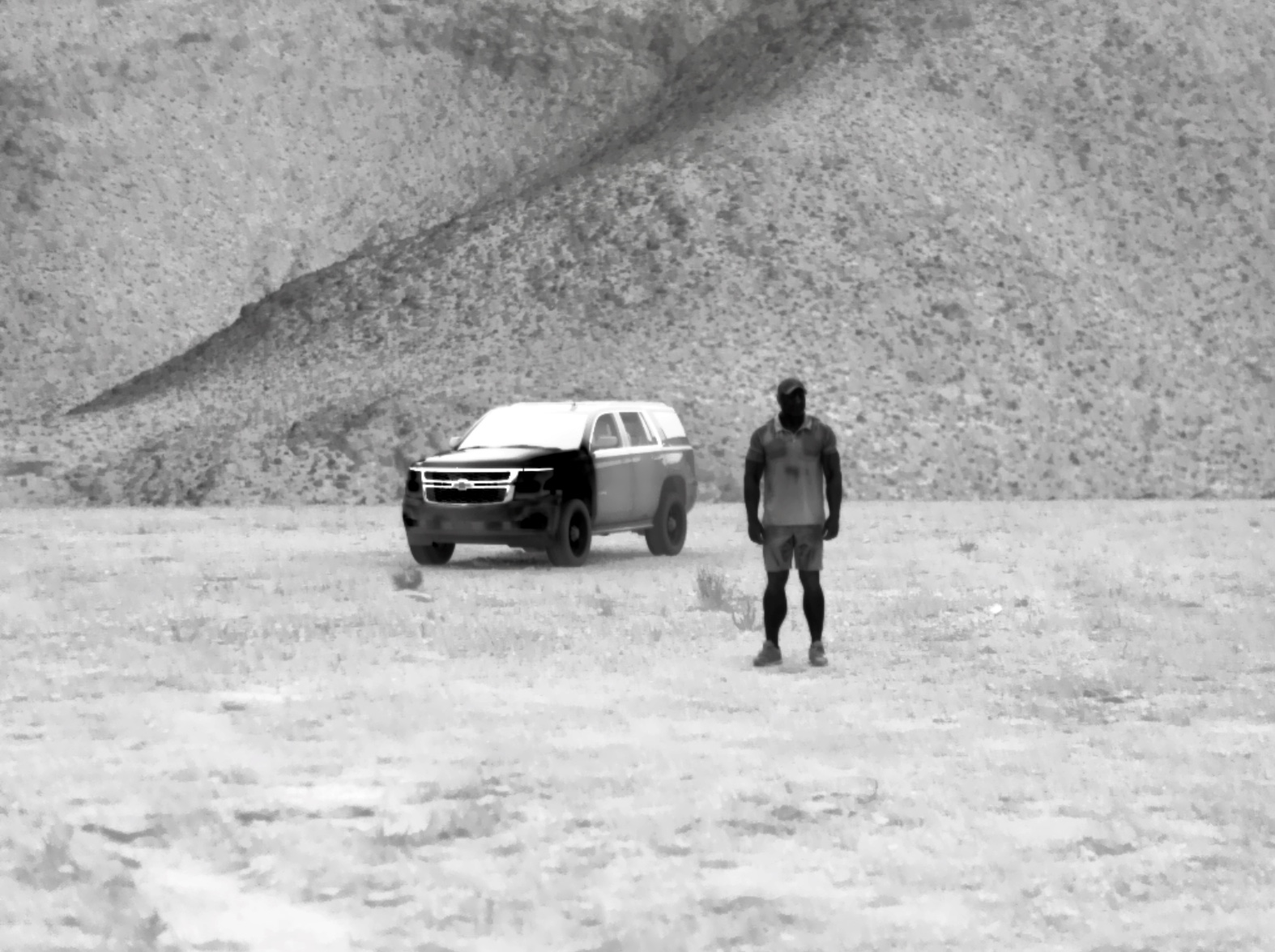 What the science behind a long range thermal imaging FLIR IR night vision PTZ pan tilt gimbal turret camera?
What the science behind a long range thermal imaging FLIR IR night vision PTZ pan tilt gimbal turret camera?
(a) Housing – Usually composed of an aluminum bell shaped cover, The housing can be of all shapes and sizes from plastic to military grade hardened coated all weather NBC Nuclear Biological Chemical compliant
(b) Camera module
This is where the image FLIR, MWIR, LWIR, SWIR, night vision, intensified, cmos, long wave, short wave, mid wave cooled and uncooled detector and sensors reside, CCD sensor, optical zoom germanium DFOV, TFOV, Fixed and CZ continuous zoom lenses, and the motors that control Zoom and Focus are located.
(c) PTZ Pan Tilt control board
The PTZ control board processes RS485 data that converts it into mechanical movements. Some are Pelco, Pelco Extended and are available in a wide array of protocols supporting VMS, GUI, ONVIF, IP, ETHERNET, FIBER, MICROWAVE, ANALOG, DIGITAL and WIRELESS
(d) PTZ motors – are the small motors that allow the thermal FLIR and CCTV HD camera to perform up, down, left and right functions. Marked by the arrows are two step motors; the one to the top controls up and down movements and the one at the bottom controls left and right movements, some systems have no motors and other methods of moving the cameras PTZ, some use brushless motors.
We can Customize your long range Pan Tilt Zoom Thermal, CCTV and other exotic sensor system to cater to your exact application,
We have facilities that can satisfy any requirement in a rapid response timeframe. We offer the worlds longest range, best weapons grade all weather IP68 hardened PTZ EOIR
imaging systems.
Long Range Visible HD CCTV cameras can compliment the Thermal cameras and assist in daytime and low light DRI (Detection, Recognition and Identification)
Long range Critical infrastructure applications require not only continuous video surveillance and monitoring, but also a solution that yields highly reliable intrusion detection, with fewer false alarms. This need makes advanced video analytics a must for any adequate long range thermal/cctv surveillance system.
Advanced analytics will provide multiple automated alarm notification options, including email, edge image storage, digital outputs or video management software (VMS) alarms. Incorporating high quality, unique and adaptive analytics can virtually eliminate false alarms, allowing security personnel to respond more efficiently and effectively, while also lowering overall cost for the end user.
While traditional long range surveillance & security technologies such as radar, thermal flir imaging and visible cameras, or video analytics work well on their own, utilizing all of these options together provide an advanced perimeter detection system. For example, ground surveillance radar can detect possible threats beyond the fence line as they approach and send a signal to pan-tilt-zoom (PTZ) cameras, triggering them to slew to a specific location. From there, embedded analytics and visible cameras can further identify objects, notify authorized staff, and collect additional evidence through facial recognition or high-quality photos.
Once a long range intrusion attempt is discovered, it is important to act fast. Organizing a response system that can initiate actions based on GPS location data, such as the slewing of FLIR PTZ cameras, automated intruder tracking or activated lighting sensors, greatly increases staff’s situational awareness while easing their workload. For instance, thermal imagers deployed in conjunction with video analytics can be used to generate an initial alarm event, which can then trigger a sequence of other security equipment and notifications for personnel to eventually respond to. Having all of this in place essentially lays the entire situation out in a way that allows responders to accurately understand and evaluate a scene.
After the designated auto-response mechanisms have activated and done their job, it is time for responders to acknowledge and assess the situation. From here, authorized personnel can take the next appropriate step toward defending against and delaying the threat. Deterring suspicious activity can be achieved through real-time two-way audio, a simple but powerful tool. Often, control room operators can diffuse a situation by speaking over an intercom, telling the trespasser that they are being watched and that the authorities have been notified.
The primary purpose of the delay facet of the overall perimeter protection strategy is to stall an attempted intrusion long enough for responders to act. Access control systems play a key role in realizing this objective. When a security officer sees a non-compliant, suspicious individual on the camera feed, the officer can lock all possible exits to trap them in one area all through the VMS.
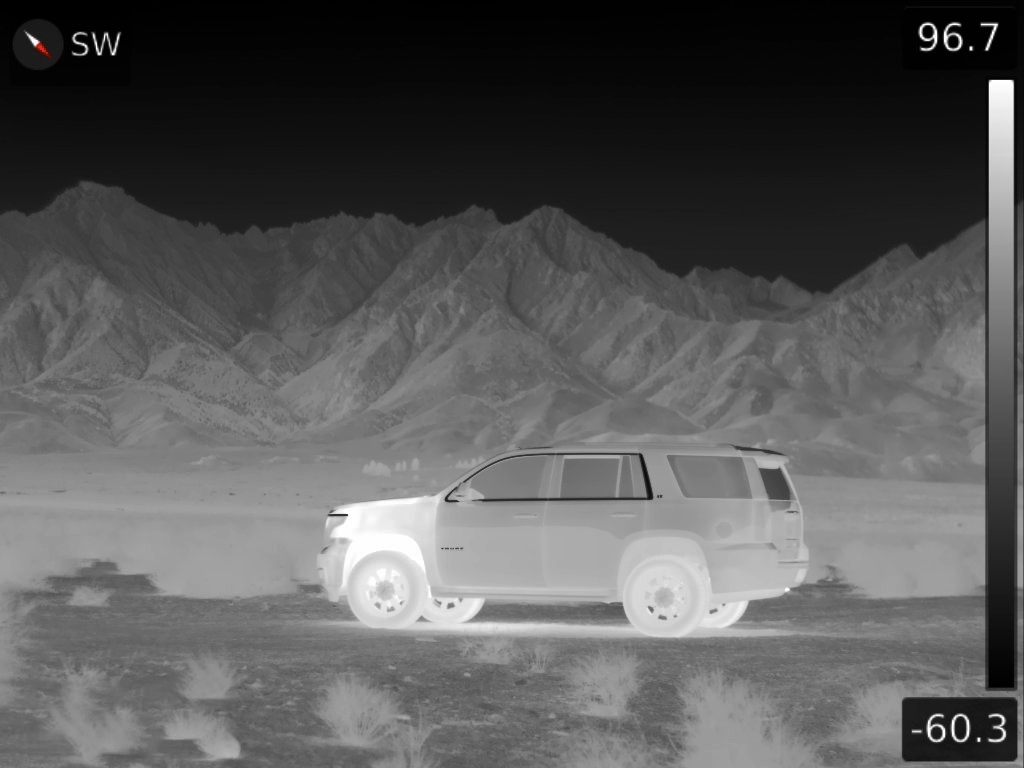
Some Long Range PTZ Thermal imaging flir camera applications;
Military combat surveillance applications
FOB perimeter/critical facility infrastructure, high value security
Border / coastline / scope truck / homeland security / AWD / 4×4 / All Terrain /frontier patrol & security
Security and surveillance
Fully Integrated Sensor Suite
Tactical Combat armored vehicle
Law Enforcement
Drone/UAV/UAS/SUAS Detection
IED Detection
Critical facility security (power stations, prisons, government offices)
Mobile, mast or tripod mounted for sea & land monitoring
Vehicle safety applications (railways, mines, heavy equipment)
Cruise ship man overboard detection & rescue
Land & sea security, search & rescue operations
Border//Frontier/Shoreline/Coast/Runway/Airstrip/Tripod/Radar Applicable
Laser IR Diode illuminators available in a variety of ranges from short/medium, long and ultra extreme long range
Military/Law Enforcement/Search and Rescue/Coastal/Frontier/Border + DEA & SWAT applications
Windows or MAC software compatibility
Remote operation with Ethernet, ip, fiber, solar, wireless, microwave gps and compass radar compatible slew to cue, slew to alert and alarm detection
Software development kit (SDK) for customized functionality / command and control
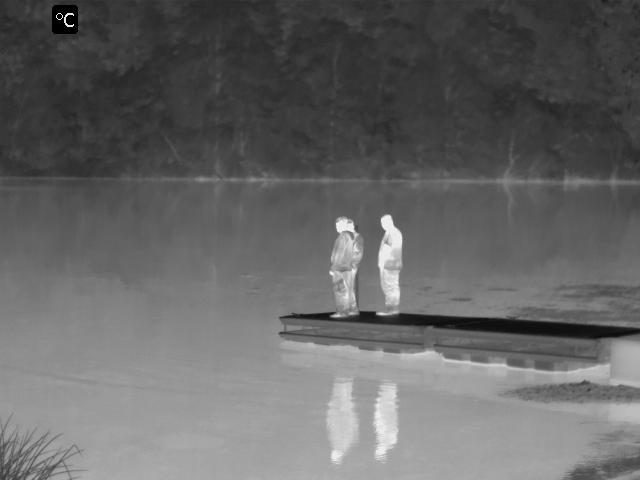 Long range Cooled MWIR flir thermal imaging PTZ cameras
Long range Cooled MWIR flir thermal imaging PTZ cameras
Cooled thermal camera systems are the preferred choice for Extreme long range thermal flir imaging. This is due to the highly sensitive FPA technology they employ. Typically, a cooled thermal camera will utilize either InSb or MCT sensor materials. These are very good materials for a thermal array in the 3-5 micron range. However, Focal Plane Arrays made from these materials do require cryogenic cooling in order to function at their peak performance level. That is why they are called “cooled thermal camera” systems. But, when these exotic sensor materials are combined with an appropriate cooling system, the result is a thermal imaging system that boasts MRTD’s on the order of 20mk or less. In practical terms this equates to 3-4 times the sensitivity of uncooled thermal camera systems. The sensitivity of cooled sensors, allows us to use much smaller lenses (f/4-f/5.5). It follows that, given a certain envelope of space, we can fit a much longer focal length lens into a cooled thermal camera design than any other technology would allow. When ultimate distance matters, long range cooled thermal camera systems are the only option.
Cooled Thermal Camera Sensor Types
Exotic materials are used to produce the focal plane array sensors that are used in cooled thermal cameras. The most common are Indium Antimonide (InSb) and Mercury Cadmium Telluride (HgCdTe).
InSb
The InSb (commonly referred to as Ins-Bee or reticulated insb) sensor material is a narrow gap semiconductor in crystaline form. It is sensitive to wavelengths of 1µm to 5µm but is typically filtered, in cooled thermal camera systems, to 3µm to 5µm. InSb detectors have long been the leading choice for imaging systems that feature long range thermal optics. It is a reliable and mature sensor technology that is manufactured in various countries around the world. The InSb detector does require cryogenic cooling to operate at peak efficiency and produce a usable thermal image. In the past ,this was accomplished by a dewar that needed to be filled with Liquid Nitrogen. The dewars are long gone. Now,highly efficient cryo coolers manage the task of cooling down to ~80°K.
HgCdTe
The HgCdTe (commonly referred to as MCT or Mer-Cad) sensor material is a narrow direct bandgap zincblende. MCT sensors are tuned to operate in wavelengths from 1µm all the way to 14µm. They are a versatile sensor material. Unlike InSb sensors, MCT sensors produce cooled thermal camera systems that access both atmospheric transmission windows of 3µm to 5µm and 7µm to 14µm. Most people think of cooled cameras as always being MWIR (3µm-5µm). MCT materials produce a cooled thermal camera that is MWIR or LWIR (7µm to 14µm). MCT focal plane arrays also require cryogenic cooling to ~80°K.
HOT HgCdTe
Hot MCT is a relatively new technology utilizing Mer Cad based sensors. The new “HOT” sensors operate at warmer temperatures than the InSb and traditional HgCdTe chips. Instead of cooling to 80°K the HOT MCT only needs to be cooled to 160°K. In practical terms this greatly reduces the load on the cryo cooler. This creates a cooled thermal camera that starts up faster, has a longer cooler lifespan and uses less power. This is fantastic for SWaP efforts. The Hot MCT is a new development that is very promising but only time will tell if it proves to be the future of cooled thermal.
In conclusion, cooled thermal camera systems incorporate different sensor materials but offer distinct advantage when used in long range and ultra long range thermal imaging platforms. The key is the increased sensitivity and smaller lens sizes.
Lenses are a key component that make up long range PTZ thermal imaging flir camera systems, after all, the long range portion is achieved with the IR optical lens. Thermal imaging lenses are typically made from Germanium, a highly expensive & exotic material.
Cooled thermal camera lenses are needed for a thermal sensor to fullfill its ultimate purpose. Highly sensitive InSb and MCT sensors are only half of the equation. To truly leverage the power of cooled thermal sensors, you need a good lens. So, what makes a good lens? Like everything of quality in life there is no one data marker that you can point to and say; “oh well if it has that then it must be the best”.
Rather, it is a combination of factors that determine a lenses quality. The main specifications of a thermal lens include: the lenses focal length, f/#, coating, alignment with the thermal sensor, size of the thermal sensor, pixel pitch of the thermal sensor, athermalization of the lens and environmental housing. That is a lot of factors. I am sure that you can now see that the question is not “what is the best cooled thermal lens” but “what is the RIGHT thermal lens for my needs”? So, with all these specifications to juggle how do I know what is the right thermal lens to choose? Lets start by looking at some of these options and figuring out what they mean.
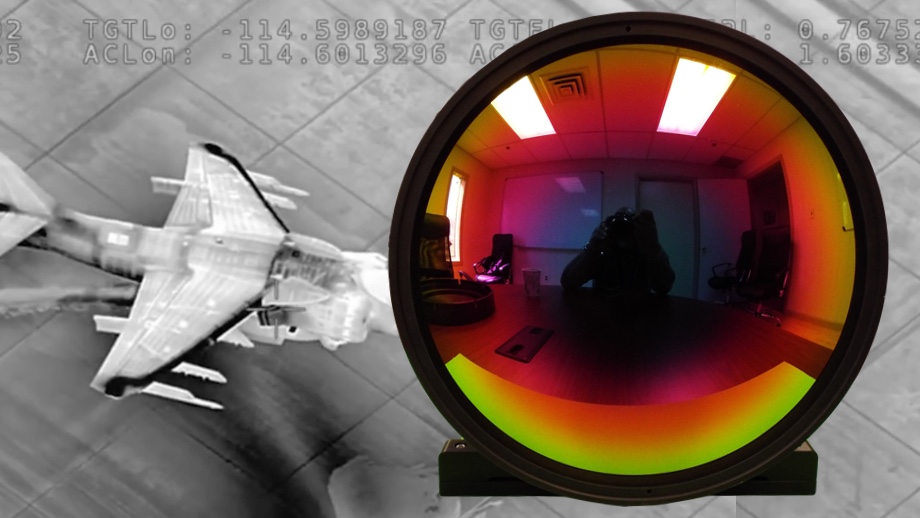 FOCAL LENGTH- When discussing long range cooled thermal camera lenses, this is going to be the first specification you come across. Quite simply the focal length is the distance from the front of the optic to the point at the back where it focuses the energy that you are imaging. In the world of long range thermal imaging it is generally assumed that a longer focal length is used to see farther distances. A longer focal length will also result in a narrower field of view. So, with long lenses you can see farther away but you see a narrower area. For example (numbers made up for ease of calculation) if a 100mm lens could see a person at 1,000 meters and had a horizontal field of view of 15 degrees, then a 1500mm lens could see a person at 15,000 meter but would have a narrow horizontal field of view of only 1 degree. This makes it easy to see far but difficult to track targets closely. That is where the cooled thermal camera ZOOM lens comes in to play. For long range thermal surveillance, the right lens in this example would be a 100mm-1500mm continuous zoom optic. This type of cooled thermal camera zoom lens provides a 100mm FOV, a 1500mm FOV and every FOV in between. The thermal zoom lens makes it easy to select the perfect FOV for the target you need to track.
FOCAL LENGTH- When discussing long range cooled thermal camera lenses, this is going to be the first specification you come across. Quite simply the focal length is the distance from the front of the optic to the point at the back where it focuses the energy that you are imaging. In the world of long range thermal imaging it is generally assumed that a longer focal length is used to see farther distances. A longer focal length will also result in a narrower field of view. So, with long lenses you can see farther away but you see a narrower area. For example (numbers made up for ease of calculation) if a 100mm lens could see a person at 1,000 meters and had a horizontal field of view of 15 degrees, then a 1500mm lens could see a person at 15,000 meter but would have a narrow horizontal field of view of only 1 degree. This makes it easy to see far but difficult to track targets closely. That is where the cooled thermal camera ZOOM lens comes in to play. For long range thermal surveillance, the right lens in this example would be a 100mm-1500mm continuous zoom optic. This type of cooled thermal camera zoom lens provides a 100mm FOV, a 1500mm FOV and every FOV in between. The thermal zoom lens makes it easy to select the perfect FOV for the target you need to track.
THE F/#- The f/# of a lens indicates the size of the opening in the front of the lens in relation to its focal length. The f/# is the ratio of that comparison. The lower the f number (known as a “fast” lens) the more energy it lens will focus onto the sensor. For example an f/1 lens indicates that the opening aperture of the lens is equal (1:1) with the focal length of the lens. So, if you have a 1500mm focal length lens @ f/1 then the opening would be a whopping 1500m diameter! This is one of the main reasons that long range thermal imaging is difficult for uncooled thermal sensors. The reduced sensitivity of uncooled sensors requires ultra fast f/1 optics. Conversely, a cooled thermal camera is 4 times more sensitive so it can be used with thermal lenses that are f/4-f/5.5. This gives you a lens that is much more manageable in the ultra long range. That same 1500mm lens at f/5.5 would only have an entrance diameter of 273mm. Clearly much smaller and more manageable. Fortunately, this is not a big concern when looking at long range cooled thermal cameras as this number is dictated by the system design and we should look to other factors to find the “right” lens.
COATING- All cooled thermal camera lenses are coated in order to perform properly and reduce unwanted stray energy. The basic anti-reflective coating is standard on all thermal lenses and is designed to eliminate that stray energy. Better lenses have whats called a DLC or HDLC coating. The Hard Diamond Like Coating of these lenses protects them from atmospheric pitting and blowing dust. In long range thermal imaging this matters. The size of these lenses usually means that the lens front element is exposed to the environment in the housing. The shear size of the lens prevents the use of IR transparent windows since they need to be so large and thick to cover the objective lens diameter. The quality of the coating is the most important thing to keep in mind. They will all be A/R and DLC and they will work great when new. But, if the coating is not applied correctly then it will quickly deteriorate leaving you with a bad image.
Click here for the history and terminology related to thermal
infrared flir imaging and night vision equipment.
